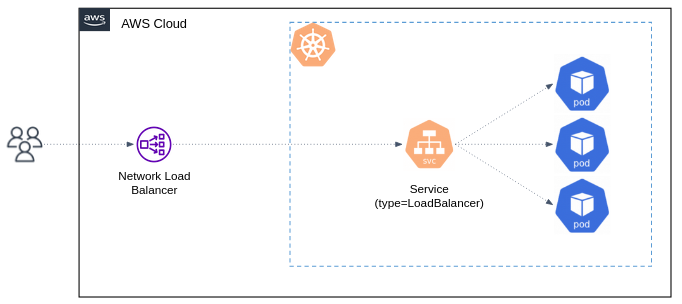The Kubernetes networking model facilitates communication between pods within a cluster, and from the outside world into the cluster.
- Pods can communicate with each other using their internal IP addresses. Every pod in a cluster can reach every other pod without NAT.
- Services provide a stable endpoint that abstracts the underlying pod instances. Services enable load balancing and automatic discovery of pod changes. Pods can use the service name as a DNS entry to connect to other services.
So far, we've seen how to use Services to publish services only for consumption inside your cluster.
Kubernetes allows you to create a Service of type=LoadBalancer (no need to apply the below example):
apiVersion: v1
kind: Service
metadata:
name: my-service
spec:
type: LoadBalancer
selector:
app.kubernetes.io/name: MyApp
ports:
- protocol: TCP
port: 80
targetPort: 9376
clusterIP: 10.0.171.239This Service takes effect only on cloud providers which support external load balancers (like AWS ELB). Applying this Service will provision a Elastic Load Balancer (ELB) for your Service.
Traffic from the Elastic Load Balancer is directed to the backend Pods by the Service. The cloud provider decides how it is load balanced across different cluster's Nodes.
Note than the actual creation of the load balancer happens asynchronously, and information about the provisioned balancer is published in the Service's .status.loadBalancer field.
A Service of type LoadBalancer is the core mechanism that allows you to expose application to clients outside the cluster.
What now? should we set up a separate Elastic Load Balancer for each Service we wish to make accessible from outside the cluster? Doesn't this approach seem inefficient and overly complex in terms of resource utilization and cost?
It is. Let's introduce an Ingress and Ingress Controller.
Ingress Controller is an application that runs in the Kubernetes cluster that manage external access to services within the cluster. There are many Ingress Controller implementations for different usages and clusters.
Nginx ingress controller is one of the popular used one.
Essentially, it's the same old good Nginx webserver app, exposed to be available outside the cluster (using Service of type LoadBalancer), and configured to route incoming traffic to different Services in the cluster (a.k.a. reverse proxy).
Ingress is another Kubernetes object, that defines the routing rules for the Ingress Controller (so you don't need to edit Nginx .conf configuration files yourself).
Let's deploy an Ingress Controller and apply an Ingress with routing rules.
Ingress controllers are not started automatically with a cluster, you have to deploy it manually. We'll deploy the Nginx Ingress Controller behind an AWS Network Load Balancer (NLB). Just apply the manifest as described in the Network Load Balancer (NLB) section.
The above manifest mainly creates:
- Deployment
ingress-nginx-controllerof the Nginx webserver. - Srvice
ingress-nginx-controllerof typeLoadBalancer. - IngressClass
nginxto be used in the Ingress objects (seeingressClassNamebelow). - RBAC related resources.
To route traffic to the NetflixFrontend service, apply the below Ingress (change values according to your configurations):
# k8s/ingress-demo.yaml
apiVersion: networking.k8s.io/v1
kind: Ingress
metadata:
name: netflix-frontend
spec:
rules:
- host: YOUR_ELB_or_ROUTE53_DOMAIN_HERE
http:
paths:
- path: /
pathType: Prefix
backend:
service:
name: YOUR_NETFLIX_FRONTEND_SERVICE_HERE
port:
number: YOUR_SERVICE_PORT_HERE
ingressClassName: nginxNginx is configured to automatically discover all ingress where ingressClassName: nginx is present, like yours.
Visit the application using the ELB or Route53 domain name.
Note
Ingress only defines the routing rules, it is not responsible for the actual routing mechanism.
An Ingress controller is responsible for fulfilling the Ingress routing rules.
In order for the Ingress resource to work, the cluster must have an Ingress Controller running.
Follow the below docs to configure your Nginx Ingress Controller to listen to HTTPS connectionS:
https://kubernetes.github.io/ingress-nginx/examples/tls-termination/#tls-termination
You can also force your incoming traffic to use HTTPS by adding the following annotation to the Ingress object:
nginx.ingress.kubernetes.io/force-ssl-redirect: "true"
You can add nginx annotations to specific Ingress objects to customize their behavior.
In some cases, you may want to "canary" a new set of changes by sending a small number of requests to a different service than the production service. The canary annotation enables the Ingress spec to act as an alternative service for requests to route to depending on the rules applied.
In this exercise we'll deploy a canary for the NetflixFrontend service.
- Deploy the NetflixFrontend service in a version which is not your most up-to-date (e.g.
0.8.0instead of0.9.0). - Now you want to deploy the newer app version (e.g.
0.9.0) but you don't confident with this deployment. Create other (separated) YAML manifests for the new version of the service, call thennetflix-frontend-canary. - Create another
Ingresspointing to your canary Deployment, as follows:
apiVersion: networking.k8s.io/v1
kind: Ingress
metadata:
name: canary
annotations:
nginx.ingress.kubernetes.io/canary: "true"
nginx.ingress.kubernetes.io/canary-weight: "5"
spec:
ingressClassName: nginx
rules:
# TODO ... Make sure the `host` entry is the same as the existed netflix-frontend Ingress. This Ingress routes 5% of the traffic to the canary deployment.
Test your configurations by periodically access the application:
/bin/sh -c "while sleep 0.05; do (wget -q -O- http://LOAD_BALANCER_DOMAIN &); done"Bonus: Use different annotations to perform a canary deployment which routes users based on a request header FOO=bar, instead of specific percentage.

